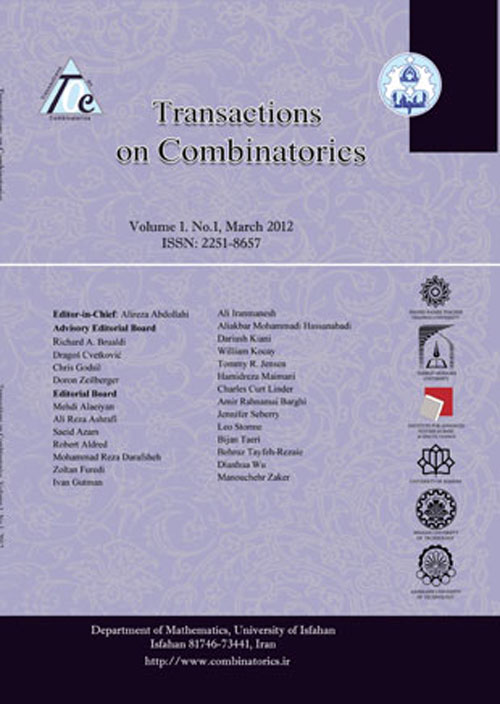فهرست مطالب

Transactions on Combinatorics
Volume:10 Issue: 2, Jun 2021
- تاریخ انتشار: 1400/01/23
- تعداد عناوین: 5
-
-
Pages 73-95For a graph $G$ on $v(G)$ vertices let $m_k(G)$ denote the number of matchings of size $k$, and consider the partition function $M_{G}(lambda)=sum_{k=0}^nm_k(G)lambda^k$. In this paper we show that if $G$ is a $d$--regular graph and $0<lambda<(4d)^{-2}$, then $$frac{1}{v(G)}ln M_G(lambda)>frac{1}{v(K_{d+1})}ln M_{K_{d+1}}(lambda).$$ The same inequality holds true if $d=3$ and $lambda<0.3575$. More precise conjectures are also given.Keywords: matchings, matching polynomial, regular graphs
-
Pages 97-106Cruz, Monsalve and Rada [Extremal values of vertex-degree-based topological indices of chemical trees, Appl. Math. Comput. 380 (2020) 125281] posed an open problem to find the maximum value of the exponential second Zagreb index for chemical trees of given order. In this paper, we solve the open problem completely.Keywords: Topological index, degree, extremal graph theory
-
Pages 107-120The characterization of the ideal access structures is one of the main open problems in secret sharing and is important from both practical and theoretical points of views. A graph-based $3-$homogeneous access structure is an access structure in which the participants are the vertices of a connected graph and every subset of the vertices is a minimal qualified subset if it has three vertices and induces a connected graph. In this paper, we introduce the graph-based $3-$homogeneous access structures and characterize the ideal graph-based $3$-homogeneous access structures. We prove that for every non-ideal graph-based $3$-homogeneous access structure over the graph $G$ with the maximum degree $d$ there exists a secret sharing scheme with an information rate $frac{1}{d+1}$. Furthermore, we mention three forbidden configurations that are useful in characterizing other families of ideal access structures.Keywords: Cryptography, Secret sharing, Ideal access structures, Graph-based access structures, 3-homogeneous access structures
-
Pages 121-128
In this paper, we compute a formula for the $a$-number of certain maximal curves given by the equation $y^{q}+y=x^{frac{q+1}{2}}$ over the finite field $mathbb{F}_{q^2}$. The same problem is studied for the maximal curve corresponding to $sum_{t=1}^s y^{q/2^t}=x^{q+1}$ with $q=2^s$, over the finite field $mathbb{F}_{q^2}$.
Keywords: $a$-number, Cartier operator, Super-singular Curves, Maximal Curves -
Pages 129-136Let $m>1$ be an integer and $Omega$ be an $m$-set. The Hamming graph $H(n,m)$ has $Omega ^{n}$ as its vertex-set, with two vertices are adjacent if and only if they differ in exactly one coordinate. In this paper, we provide a new proof on the automorphism group of the Hamming graph $H(n,m)$. Although our result is not new (CE Praeger, C Schneider, Permutation groups and Cartesian decompositions, Cambridge University Press, 2018), we believe that our proof is shorter and more elementary than the known proofs for determining the automorphism group of Hamming graph.Keywords: Automorphism group, Hamming graph, vertex-transitive graph, wreath product

